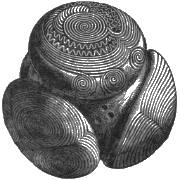Canmore Site 38700: BALNABRAID - CAMPBELTOWN - CIST(S) (BRONZE AGE), CREMATION (BRONZE AGE), INHUMATION (BRONZE AGE), KERB CAIRN (BRONZE AGE), BEAD(S) (JET)(BRONZE AGE), BEAKER (BRONZE AGE), FOOD VESSEL(S) (BRONZE AGE), KNIFE (FLINT)(BRONZE AGE)
Description
| Site Name | BALNABRAID |
|---|---|
| Other Name(s) | n/a |
| Site Number | NR71NE 2 |
| Broad Class | DRESS AND PERSONAL ACCESSORIES, MONUMENT (BY FORM), FOOD PREPARATION AND CONSUMPTION, TOOLS AND EQUIPMENT, RELIGIOUS RITUAL AND FUNERARY, CONTAINER |
| Site Type(s) | CIST(S) (BRONZE AGE), CREMATION (BRONZE AGE), INHUMATION (BRONZE AGE), KERB CAIRN (BRONZE AGE), BEAD(S) (JET)(BRONZE AGE), BEAKER (BRONZE AGE), FOOD VESSEL(S) (BRONZE AGE), KNIFE (FLINT)(BRONZE AGE) |
| NGR | NR 7679 1550 |
| NGR accuracy | NGR given to the nearest 10m |
| Local Authority | ARGYLL AND BUTE |
| Parish | CAMPBELTOWN |
| Record created | 1988-03-21 |
| Last updated | 2000-05-22 |
Archaeology Notes
NR71NE 2 7679 1550.
(NR 7680 1551) Cairn (NR) Stone Cists and Urn found AD 1910 (NAT)
OS 6" map, Argyllshire, 2nd ed., (1924)
A multiple-cist Bronze Age cairn first noticed in 1910 when erosion of its banks by the Balnabraid Burn revealed a cinerary urn in the exposed face of the cairn material. Excavations took place in 1910, 1913 and 1966. The cairn now measures about 14.5m by 7.5m, but the SW part has been destroyed. Composed entirely of stone, it stood to a height of 3m before excavation, and exhibited a kerb of large boulders on the NW and SE, of which only a few indications are now visible. The monument has been referred to as a chambered cairn in the past but it is now accepted (Henshall 1972) that the setting of stones which runs west from Cist 3 on the plan (RCAHMS 1971) (which is based on the published reports) is not in fact part of a chambered tomb although its purpose remains unexplained.
Eleven cists were discovered during the investigations and these produced a beaker with jet disc-beads and a flint knife, three food-vessels and a cinerary urn. Two of the food-vessels come from cists outside the kerb, one being especially interesting since it accompained a crouched inhumation which overlay, in the same cist, an earlier cremation which has been sealed by a layer of clay. Several possibly Early Iron Age uncisted inhumations had been inserted into the cairn material.
The funerary vessels cover a period from about the 17th century to the 15th century BC and a bronze razor, probably dating from 1400 to 1000 BC, was found on the site in 1966.
D M'Kinlay 1911; T L Galloway 1920; J N G Ritchie 1967; A S Henshall 1972; RCAHMS 1971, visited 1966.
The cairn has been back-filled after excavation leaving only a few kerb stones as distinguishable features. A restored cinerary urn from the site is in the Campbeltown Museum; other finds are in the Hunterian Museum.
Surveyed at 1:10 000.
Visited by OS (JB) 24 October 1977.
Identifiers and Links to Other Records
Would you like to help find more links?
This area is visible only to logged in users.
